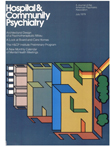A Longitudinal Study of Neurosis in Young Men
Abstract
Because of the widely varying symptomatology seen in the neuroses, questions have been raised about whether they constitute a realistically defined category of illness. The authors followed 4074 Navy enlisted men diagnosed as neurotic between 1966 and 1969 and compared disposition decisions and posthopital outcomes for four major neurotic subtypes (anxiety, hysterical, depressive, and phobic-obsessive-compulsive). Neurotic patients as a group were also compared with patients in other diagnostic categories. Although posthospital outcomes were found to differ among the four neurotic subtypes, the differences were not large when compared with the differences between the neuroses as a group and other major diagnostic categories. Those findings suggest that the neuroses are a distinct group with regard to outcome, and that the use of this diagnostic category should not be abandoned without further study.
Access content
To read the fulltext, please use one of the options below to sign in or purchase access.- Personal login
- Institutional Login
- Sign in via OpenAthens
- Register for access
-
Please login/register if you wish to pair your device and check access availability.
Not a subscriber?
PsychiatryOnline subscription options offer access to the DSM-5 library, books, journals, CME, and patient resources. This all-in-one virtual library provides psychiatrists and mental health professionals with key resources for diagnosis, treatment, research, and professional development.
Need more help? PsychiatryOnline Customer Service may be reached by emailing [email protected] or by calling 800-368-5777 (in the U.S.) or 703-907-7322 (outside the U.S.).



